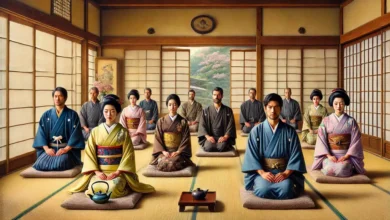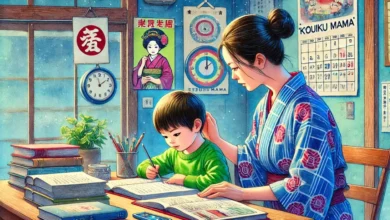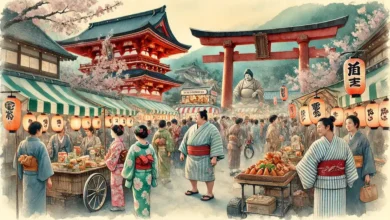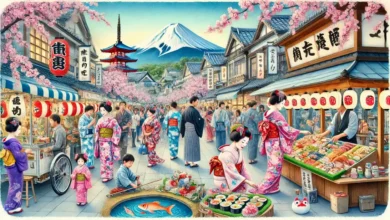1001 Japan Matsuri – The Best Traditional Festivals in Japan
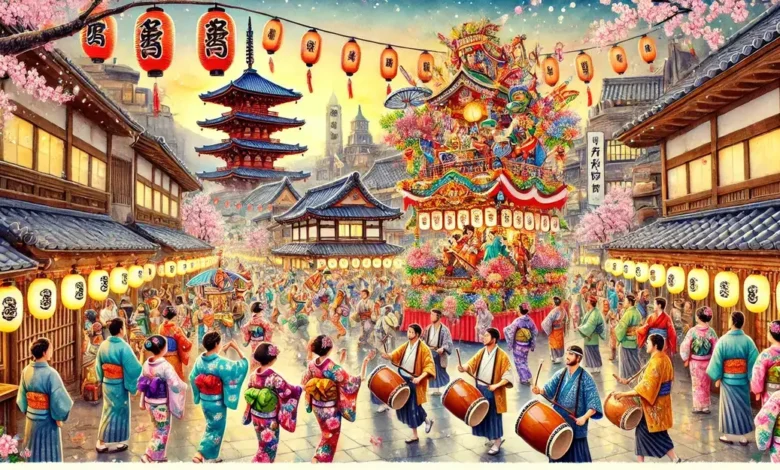
Japan Matsuri, or Japanese festivals, are often beautiful, bursting with color, excitement, and tradition. Japan has more unique festivals than any other country. Going to a Matsuri is a special experience.
If you want to see Japan’s lively side, go to a high-energy Matsuri! The activities change based on the festival. But, most of the time, you’ll see people singing, dancing, and carrying big, beautifully decorated “mikoshi” (portable shrines) or floats.
Matsuri are also great places to try different Japanese foods. Street food isn’t very common in Japan, unlike other parts of Asia. But during Matsuri, you’ll find lots of “yatai” (food stalls) lining the streets. Each one offers a unique selection of festival treats, some healthy and some not so much. It’s a fun way to try new foods! So, if you ever get a chance to visit a Matsuri, don’t miss it! It’s a once-in-a-lifetime experience that you’ll never forget. Enjoy the food, the colors, and the energy of a true Japanese festival!
The last time this page was updated was in October of 2022.

The Best Japanese Festivals: Our Favorite Matsuri
There are far too many excellent matsuri in Japan to mention in a single list, and some of the most pleasant are unsung events hosted in little towns around the country. We present an introduction to what we think to be some of the greatest and most intriguing Japanese festivals in our festival guide below, which includes:
- Gion Matsuri is a traditional Japanese festival held in Kyoto.
- Tenjin Matsuri in Osaka
- Nebuta Matsuri in Aomori
- Tokushima’s Awa Odori event
- And there are many more!
The following is a list of upcoming Japanese Matsuri (Festivals)
If you’re planning a trip to Japan and want to check out some festivals, we have a list for you. This list of important “Matsuri” (festivals) is updated often.
Festivals happen all year in Japan. Some of the most famous ones are in the summer. Summer in Japan is hot and sticky. But, this weather adds to the fun and lively mood at many Matsuri. So, if you’re going to Japan, try to go during a festival. It’s a great way to experience Japanese culture! Remember, we keep our list updated, so check back often to see what’s happening. Happy travels!
Upcoming Festivals (Matsuri) in Japan in 2023
- February 4-11: Sapporo Yuki Matsuri Snow Festival (Sapporo)
- April 14-15: Takayama Spring Festival (Takayama)
- May 15: Aoi Matsuri (Kyoto)
- May 20-22: Sanja Matsuri (Tokyo)
- Month of July: Gion Matsuri (Kyoto) (Main parades, evenings of July 17th and 24th)
- July 22-23: Tenjin Matsuri (Osaka)
- July 29: Katsushika Noryo Fireworks Festival (Tokyo)
- July 30: Sumidagawa Fireworks Festival (Tokyo)
- August 2-7: Nebuta Matsuri (Aomori)
- August 5: Edogawa Fireworks Festival (Tokyo)
- August 6: Naniwa Yodogawa Fireworks Festival (Osaka)
- August 12-15: Awa Odori (Shikoku)
- August TBD: Hokkai Bon Odori (Sapporo) (15th day of the 7th lunar month; lasts for three days)
- August 16: Kyoto Gozan Okuribi, aka Daimonji Festival (Kyoto)
- October 9-10: Takayama Fall Festival (Takayama)
- October 22: Kurama Fire Festival (Kyoto)
- October 22: Jidai Matsuri (Kyoto)
- November 4, 16, 28: Asakusa Torinoichi Fair (Tokyo) (Held on Days of the Rooster in November; Days of the Rooster occur every 12 days throughout the month)
- December 2-3: Chichibu Yomatsuri (Saitama)
Note: The dates for some festivals in 2023 may be subject to change, so it’s best to check for updates closer to the event dates.

Japan Matsuri – The Best Festivals in Tokyo
We’ll start with a list of the greatest events in Tokyo.
Kanda Matsuri is a traditional Japanese festival (Kanda Myojin Shrine, Tokyo)
Kanda is a key area in Tokyo, both in the past and now. One of Tokyo’s top three festivals, the Kanda Matsuri, takes place here.
This festival only happens in odd-numbered years and lasts a week. The big parade is on the Saturday closest to May 15th. Over 300 people walk through downtown Tokyo, carrying 100 “mikoshi” (portable shrines).
The Kanda Matsuri started to celebrate Tokugawa Ieyasu’s win at the Battle of Sekigahara. It grew into a display of wealth for the new leaders of the Edo period.
Now, the festival is a symbol of wealth for the locals. It’s amazing to watch the parade of portable shrines, singers, priests on horseback, and dancers. They march through the streets, blessing people as they pass by. The parade ends at the Kanda Myojin Shrine. It’s a sight you won’t want to miss! So, if you’re in Tokyo during an odd-numbered year, make sure to check it out!

Sanja Matsuri is a character in the film Sanja Matsuri (Asakusa Shrine, Tokyo)
Sanja Matsuri is a lively festival in Tokyo’s old Asakusa area. It happens on the third Sunday of May and the two days before.
This festival honors the three founders of Senso-ji Temple. They are remembered in the Asakusa Shrine next door. Over three days, more than 2 million people come to join. It’s the biggest Shinto celebration in Tokyo.
Legend says the three founders found a small statue of the Boddhisatva Kannon while fishing in the Sumida River. This happened one morning in the 7th century, and they became Buddhists. The shrine has been around since 1649, even though the event might be older.
The festival is full of games and food. It’s known for being loud and fun. You’ll hear flutes, drums, and lots of shouting. On Sunday, the festival’s main day, three “mikoshi” (portable shrines) are carried through the streets. Each one holds the spirit of a founder. They end up at the Asakusa Shrine. The more noise and shaking, the more good luck for the people nearby. So, if you’re in Tokyo in May, don’t miss the Sanja Matsuri!

The Best Festivals in Kyoto: Matsuri
The following is a list of some of our favorite festivals in Kyoto.
Matsuri Aoi (Kamigamo Shrine, Kyoto)
The Aoi Matsuri, or Kamo Matsuri, is a big, beautiful festival in Kyoto, Japan. It includes a parade from the Kyoto Imperial Palace to the Kamo Shrine. People dress up in old-fashioned clothes from the Heian period (794-1185). Some ride horses or go in ox-drawn carriages. Others walk and play Heian court music.
This festival started before the Heian era, maybe as early as the 6th century. Back then, Emperor Kinmei would give offerings to the Kamo Shrine to stop natural disasters. Over time, this turned into a big parade. The festival is named after the hollyhock (aoi) flowers that people wear on their clothes and carriages. These flowers were thought to bring good luck and protect against disasters.
The Aoi Matsuri parade starts at 10:30 a.m. at the Imperial Palace and ends around 3:30 p.m. at Kamigamo Shrine. There are also horse competitions and other activities in the days before the parade. So, if you’re in Kyoto in May, make sure to check out the Aoi Matsuri!

Gion Matsuri is a traditional Japanese festival (Yasaka Shrine, Kyoto)
Gion Matsuri is a famous and big festival in Japan. It started in 869 and happens every July. The main event is on July 17th with a parade called Yamaboko Junko.
There are lots of activities all month, but the biggest ones are on July 17th and the three nights before. These nights are called yoiyama evenings.
There are two types of floats in the parade: small “yama” floats and big “hoko” floats. Hoko floats can be as tall as a building (about 25 meters) and weigh as much as 12 tons. They’re decorated with beautiful tapestries and lanterns. It takes about 40 people to move a hoko float!
During the festival, the streets are full of people. There are food booths, performances, music, and costumes. You might even see geiko and maiko! It’s a great chance to see the people of Kyoto having fun and to see the amazing floats up close.
At the same time, there’s another event called the Byobu Matsuri, or “Folding Screen Festival”. Many homes in Kyoto open their doors to the public. Visitors can see special family treasures.
On July 24th, there’s a smaller parade with fewer floats. This parade also has its own yoiyama nights of celebration. So, if you’re in Kyoto in July, make sure to check out the Gion Matsuri!

The Best Matsuri in Japan Aside from Tokyo and Kyoto,
It’s a fool’s errand to try to condense all of Japan’s festivals into a top ten list, but here’s a taste of our favorites.
Matsuri Nebuta (Aomori Prefecture)
Nebuta Matsuri is a beautiful festival in Aomori, the northernmost part of Japan. During this festival, the streets of Aomori City are filled with bright lantern floats. These floats can take a year to make!
The floats are made of “washi” (Japanese paper) and lit up from the inside. They show tall gods, warriors, kabuki actors, animals, and even TV stars. Dancers, drummers, flutists, and other musicians perform next to the floats.
Anyone can join the dancer parade if they wear the traditional “haneto” dancer’s clothes. You can find these clothes all over the city.
What makes Nebuta Matsuri special is that it has parades every night of the festival week. The only exception is the last day, when the parade is in the afternoon. So, if you’re in Aomori during Nebuta Matsuri, make sure to check it out! It’s a sight you won’t forget.

Yuki Matsuri in Sapporo (Snow Festival, Sapporo, Hokkaido)
Every February, the city of Sapporo — Hokkaido’s biggest city — hosts Sapporo Yuki Matsuri, one of the world’s major snow and ice festivals, as we mentioned in our piece on the best reasons to visit Japan in winter.
The Sapporo Snow Festival, which started in 1950, is a big event. Each year, over two million people come to see the amazing ice and snow sculptures. You can see the hard work and skill that goes into making them during the day. But, they’re even more beautiful at night when they’re lit up.
But there’s more to the festival than just the sculptures. The Yuki Matsuri has lots of fun activities for kids and adults. There are concerts, a snow sculpture contest with teams from around the world, food events, snowball fights, and snow slides. There are even ice bars!

Takayama Matsuri (Takayama, Gifu Prefecture)
Takayama’s Spring and Autumn Matsuri are some of Japan’s best festivals. They happen in Takayama, a lovely, old town in the Japan Alps.
Takayama is famous in Japan for its skilled crafters. Their work is shown at the yatai festival. Here, “yatai” means parade floats, not food stalls. The floats are made with carved wood, lacquer paintings, metal work, woven fabrics, and big moving puppets.
The floats on wheels are amazing, but the puppet shows are the best part. A puppet master controls the puppets with lots of strings and rods from inside the float.
The Spring Festival, or Haru no Takayama Matsuri, is in southern Takayama at Hie Shrine. People pray for a good crop after planting season. The Autumn Festival, or Aki no Takayama Matsuri, is in northern Takayama at Hachiman Shrine. People give thanks for the crops they’ve gathered.
Both festivals are worth seeing. They show off the beautiful yatai and have a magical night parade, or yomatsuri, on the first night. When it gets dark, the floats light up with hundreds of lanterns. Dancers and musicians in costumes join the floats. They go through the streets of Takayama, passing by the town’s pretty bridges. It’s a sight you won’t want to miss!

Tenjin Matsuri (Tenmangu Shrine, Osaka)
The Tenjin Matsuri, or “Festival of the Gods,” is a fun festival in Osaka, Japan. It happens at the end of July.
This festival honors Sugawara no Michizane. He was a poet and scholar in the Heian period. People worship him at Osaka’s Tenmangu Shrine. He’s the god of art and education. During the festival, people carry a “mikoshi” (portable shrine) with his spirit. There are also dancers, musicians, and even goblins on horseback!
Even though the Tenjin Matsuri has a long history of over 1,000 years, it’s all about having fun. There are lots of food stalls and street parties.
The best part is on the second day. That’s when 3,000 people dressed in Heian clothes parade through the streets. Then they get on boats with torches and sail down the Okawa River. The night ends with a big fireworks show over the river.

Awa Odori (Tokushima, Shikoku)
The Awa Odori (Awa Dance) festival started in a place called Tokushima on the island of Shikoku. It’s a fun event with a long history.
Legend says that a lord threw a big party to celebrate the opening of Tokushima castle in the late 16th century. People started singing and dancing to music. This turned into a yearly event and is now one of Japan’s most fun festivals.
Every year, over a million tourists come to Shikoku for Awa Odori. Even though Shikoku is a bit out of the way, it’s worth the trip. The festival has amazing traditional clothes, powerful dances, and intense music. It’s really a big, fun dance competition.
The parade has different dance teams. Each team has its own clothes and dance style. The dance is called the “fool’s dance” and the mood is like a party. The lyrics say, “The dancers are idiots, and the ones watching are fools. So why not dance, because everyone is a fool?”
If you can’t go to Tokushima, you can check out the Awa Odori in Tokyo. It’s been held in the Koenji area since the 1950s.
Even though Tokyo’s Awa Odori is smaller than the one in Shikoku, it still draws over a million people each year. It’s in the Koenji district, a cool area just west of Shinjuku known for great food, music, and vintage stores.

Chichibu Yomatsuri (Chichibu Shrine, Saitama Prefecture)
The Chichibu Yomatsuri is a beautiful float festival in Japan. It’s about 90 minutes away from Tokyo. The floats are moved by people and can weigh as much as 20 tons. During the day, the floats are like stages for kabuki shows.
The Chichibu Yomatsuri is also a night festival, or “yomatsuri”. The floats are covered with bright lanterns. There are drummers, flute players, and “mikoshi” (portable shrines) from the old Chichibu Shrine, which is 2,000 years old.
At the end of the festival, people push the floats up a hill. The night ends with a two-hour fireworks show. It’s a special treat in the winter. So, if you’re in Japan during the Chichibu Yomatsuri, make sure to check it out. It’s a sight you won’t forget!

Hanabi (Fireworks) Matsuri
If you visit Japan in the summer, you might see a hanabi (fireworks) festival. In Japan, fireworks are like art. The people who make them take their job very seriously!
These hanabi festivals happen all over Japan in the summer. They can be big events in cities like Tokyo and Osaka, or smaller ones in little towns. These festivals are a great way to relax, hang out with friends and family, and enjoy some food and drinks.
Here are some of the most famous hanabi festivals in Japan. Remember to get there early if you want to see a popular fireworks show!

Sumidagawa Fireworks Festival
The biggest fireworks festival in Tokyo happens along the Sumida River. It’s so big that about one million people come to see it! The festival has two different parts, both on the river. It’s a lot of fun!
Edogawa Fireworks Festival
One of the biggest fireworks shows in Tokyo happens on the Edogawa River. This event takes place in Asakusa, a part of Tokyo that’s close to the Senso-ji Temple. It’s a sight to see!
Katsushika Noryo Fireworks Festival
This festival is smaller than the big ones in Tokyo, but it’s a great choice if you want a good view of the fireworks. You can walk through old streets to get to the Shibamata Taishakuten Temple, where you can watch the fireworks. It’s a fun adventure!

This festival, which is one of Osaka’s most well-known summer events, is fully planned and administered by volunteers. The hanabi show is best known for its unique, hand-crafted fireworks.
Other Great Festivals in Japan (Honorable Mentions)
We couldn’t leave out a couple of honorable mentions, but there are plenty more!
Omizutori omizutori omizu (Todaiji Temple, Nara)
Priests carrying flaming torches ascend up to the balcony of Todaiji Temple’s Nigatsudo Hall every evening after sunset during the gorgeous Omizutori. The falling embers are said to grant the attendees below a safe year ahead, in addition to the beauty of the spectacle and lovely views of Nara from Nigatsudo.
Kanamara Matsuri (Kanamaya Shrine, Kawasaki)
The famous Kanamara Matsuri, also known as the “Festival of the Steel Phallus,” is held in Kawasaki, a city near Tokyo. At this festival, you’ll find unique mikoshi (portable shrines), candies, and souvenirs. All of these are shaped like symbols of fertility, which fits the festival’s theme. This festival is a fun and lively event. Plus, it gives its profits to research for AIDS and HIV. It’s a good time for a good cause!
Kanto Matsuri (Akita Prefecture)
At the Kanto Matsuri, also known as the “Pole Lantern Festival,” performers balance big bamboo poles with lanterns on them. Drummers and other musicians play music too. The best part of the festival is the night parades. That’s when they light the lanterns with candles. The performers do amazing balancing acts in the glow of the lanterns.
Nagasaki Kunchi (Suwa Shrine, Nagasaki)
Nagasaki Kunchi is a festival in Nagasaki, a city with a rich history and many cultures. This festival celebrates the Dutch and Chinese influences on Nagasaki. There are performances that show these influences, like Chinese lion dances and big floats shaped like ships. These performances happen in different parts of the city. Some of the big shows cost money to see, but there are also many free activities all over the city. It’s a fun way to learn about Nagasaki’s history and culture!
Jidai Matsuri (Heian Shrine, Kyoto)
The Jidai Matsuri, or “Age Festival,” in Kyoto is like a time machine. It takes you back to when Kyoto was the capital of Japan for a thousand years. In this festival, you can see a big parade that shows what Kyoto was like in the past. Over 2,000 people dress up as samurai soldiers, princesses from the Heian court, geisha, and other important people from history. They walk in a line from the Imperial Palace to the Heian Shrine. It’s like a living picture of Kyoto’s history! It’s a great way to learn about the past and have fun at the same time.
More Matsuri Resources in Japan
Hopefully this has piqued your interest in visiting Japan and attending a lively matsuri or two!
Please bear in mind that many of the aforementioned events — particularly the most popular, such as the Sapporo Yuki Matsuri and the Takayama Festivals — need extensive preparation ahead of time, since lodgings sometimes sell out months in advance.

